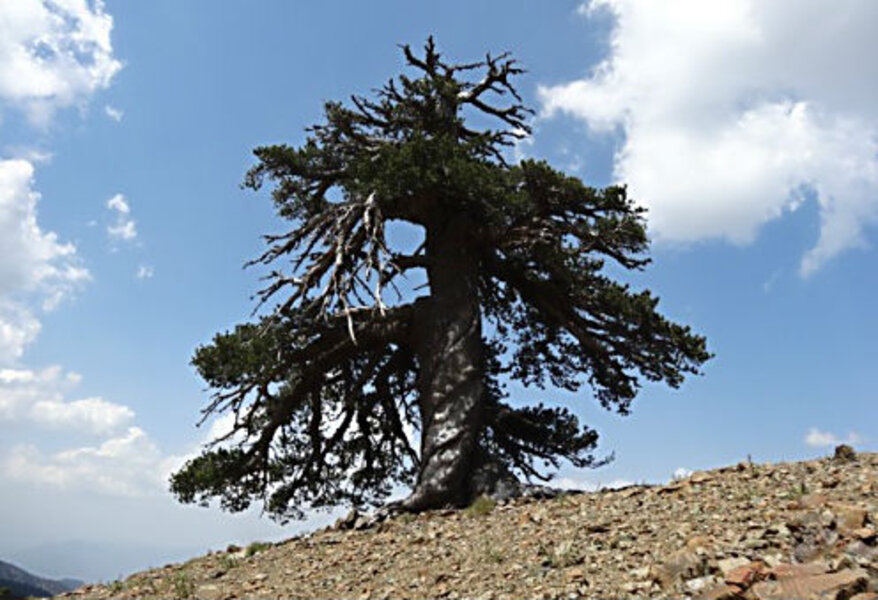This tree in Greece is Europe's oldest known living tree
Loading...
European history has had one continuous observer for more than a thousand years: a pine tree in Greece.
Dendrochronologists have calculated the tree’s age to be at least 1,075 years old, making it the oldest tree in Europe. This little pine, nicknamed “Adonis,” has seen world wars, a century of revolutions, the Protestant Reformation, the Crusades, and a good chunk of the Dark Ages.
"The tree we have stumbled across is a unique individual," said Stockholm University graduate student Paul J. Krusic, according to the Washington Post. "It cannot rely on a mother plant, or the ability to split or clone itself, to survive."
He's referring to trees that repeatedly clone themselves, so a tree living now is genetically identical to one living more than 10,000 years ago. Tree systems like those have been called the oldest trees in the world, but the individual trees live only a few hundred years before asexually spawning a replacement clone.
This tree has, itself, lived through more than a thousand years of history.
"Cloning is a very effective evolutionary survival strategy," said Mr. Krusic. "It's cool, but it's not the same. It's not the same as you or I being left alone to our own devices and living for 1,000 years, like this tree."
Some other trees have been estimated to be a lot older than Adonis, but therein lies the rub. Estimation does not make an ancient tree, at least in the eyes of scientists. This tiny tree creates one new trunk ring each year, making it comparatively easy for scientists to determine its age.
According to Mr. Krusic, who was part of the team that counted tree rings for the study, Adonis is actually more than 1,075 years old. The scientists who took the pencil-sized core samples from Adonis’ tree trunk didn't reach the center of the tree, so it has more rings that they couldn't count.
"I am impressed, in the context of western civilization, all the human history that has surrounded this tree; all the empires, the Byzantine, the Ottoman, all the people living in this region,” Krusic said, according to Phys.org. “So many things could have led to its demise. Fortunately, this forest has been basically untouched for over a thousand years."
Elderly trees are rare in Europe, although they are relatively common in other parts of the world, including the United States. The reason has a lot to do with humans – the more human traffic there is in a region, the more likely a tree is to be chopped down for a human purpose, whether firewood or construction or to make room for development.
In Greece, Adonis and its neighbors are just a few miles from civilization, making their survival all the more unusual. Their proximity is very interesting to researchers, who plan to study fallen trees nearby to determine the what fingerprints humans have left on the region.
"That has a story in it. A story about climate change, about human influences," said Krusic, according to the Washington Post. "That's the real story we're working on. This is just something we stumbled upon."
Scientists say that many of the trees in the ancient Greek forest where Adonis was discovered are remniscent of elderly trees they have seen in the United States. And, as it happens, Adonis lives in nature’s version of a retirement home - several of Adonis’ neighbors are also around 1,000 years old.
Elsewhere, scientists are using trees to push back against human influence. In 2009, The Christian Science Monitor’s Andy Nelson reported on dendrochronologists in Vietnam, who use wood dating in ancient Vietnamese forests to monitor how forests have responded to monsoon seasons and precipitation.
“It’s not simply that we want to understand the rules of the climate system.... We want to understand how those rules interact,” said tree researcher Kevin Anchukaitis in 2009. “In chess, each move that a player makes in the game is going to influence the subsequent move, so there are long-term consequences of each individual move.”
More recently, in California, researchers seeking to understand how trees can combat drought and climate change have looked to the state’s famed sequoia trees, which have withstood extreme conditions while performing essential services to the environment, providing homes for countless animals and converting carbon dioxide into oxygen.








